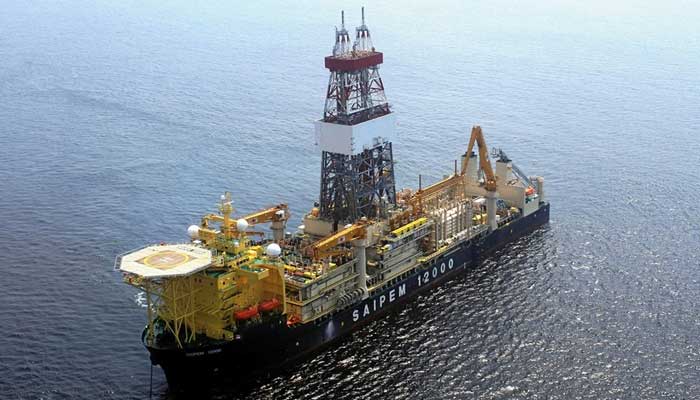Govt pins hope on offshore Kekra-1 drilling for hydrocarbon jackpot
KARACHI: Pakistan’s economy and the energy sector are currently betting on a new oil and gas discovery, as a consortium of foreign and local companies have started offshore spud work some 230 kilometres from Karachi where reserves are likely to be more than the Sui field.
An exploration fleet consisting of a major drilling ship, three supply vessels and two helicopters, started drilling work and have compiled a 12-hour preliminary report for onward submission to the companies experts, officials said.
The drilling would be carried out at Kekra-1 of the Indus G-block around 5,800 meters deep from the sea level, and was expected to be completed in a period of two months at a cost of $70-$80 million, to be contributed equally by the joint venture partners.
The operator of the block, ENI (an Italian company working in Pakistan’s upstream sector since 2000) has chartered Saipem 12000 rig/ship to drill the exploration well, located 230 kilometres southwest of Karachi.
The joint venture has been formed by ENI, ExxonMobil (that has come back to Pakistan after nearly three decades), Oil and Gas Development Company (OGDC), and Pakistan Petroleum (PPL) to spud the Kekra-1 exploration well.
Officials said the government was committed to extending all possible facilities to the companies interested in carrying out offshore drilling activities, including Customs duty exemption on the import of offshore drilling equipment, as Pakistan was in dire need of a major gas and oil discovery.
Experts believe there are massive hydrocarbon reserves offshore that would be sufficient for 50-year needs of the country.
Topline Securities in a report said companies and government officials were calling the exploration endeavour a possible “game changer” for Pakistan, which meets up to only 49 percent of its oil and gas need, in barrels of oil equivalent, through local production.
Analyst Nabeel Khursheed of Topline Securities said, “Some are calling the anticipated discovery to be even bigger than the Sui field (currently second biggest gas field after Mari with current production at around 400mcfd or 10 percent of total gas production), as the block was estimated to be rich in gas reserves.”
Gas flow from Sui when at prime stage was as high as 800 mmcf/day of gas, whereas the reserves of the field were around 10 to 12 trillion cubic feet. When found several decades back it was 7 to 8 trillion cubic feet of gas.
“By or before April 2019, the companies will be in a position to assess the potential hydrocarbon flows from this offshore drilling along with their economic viability. Setting up the necessary infrastructure to make hydrocarbon flows commercially available can take 3-5 years,” he added.
Offshore success could be a real game changer for Pakistan E&Ps, as offshore Indus G-block falls under the ‘Ultradeep’ Zone-0 price mechanism. It has been estimated that at Arab Light Crude $60/bbl, the gas from Indus-G would be priced at $7.2/mmbtu with additional $1/mmbtu as an incentive for first three discoveries in offshore area, as per Petroleum Policy 2012 (PP12).
The said zone was competitively priced, offering premium of 80 percent, in comparison to the average applicable pricing on onshore blocks under older policies.
However, there have been warnings too of another dry well, as has been experienced in the past. Pakistan has drilled 17 offshore wells to date and most failed to reach the target reservoirs.
The last offshore well Shark-1, a JV of PPL and ENI was spud in 2010 at exploration cost of $40-$45 million, and was found to be commercially unfeasible after three months of drilling.
If drilling in Indus G-block turns out to be unsuccessful, it could be another blow to Pakistan and its exploration companies that were in dire need of some major discoveries given fast depleting hydrocarbon reserves.
-
 'Percy Jackson' Star Feels Relieved After Season Two Finale
'Percy Jackson' Star Feels Relieved After Season Two Finale -
 Jelly Roll Reveals How Weight Loss Changed Him As A Dad: 'Whole Different Human'
Jelly Roll Reveals How Weight Loss Changed Him As A Dad: 'Whole Different Human' -
 Prince Harry Gets Emotional During Trial: Here's Why
Prince Harry Gets Emotional During Trial: Here's Why -
 Queen Camilla Supports Charity's Work On Cancer With Latest Visit
Queen Camilla Supports Charity's Work On Cancer With Latest Visit -
 Dove Cameron Opens Up About Her Latest Gig Alongside Avan Jogia
Dove Cameron Opens Up About Her Latest Gig Alongside Avan Jogia -
 Petition Against Blake Lively PGA Letter Gains Traction After Texts With Taylor Swift Revealed
Petition Against Blake Lively PGA Letter Gains Traction After Texts With Taylor Swift Revealed -
 Netflix Revises Warner Bros. Deal To $83 Billion: All-cash Offer
Netflix Revises Warner Bros. Deal To $83 Billion: All-cash Offer -
 Prince Harry Mentions Ex-girlfriend Chelsy Davy In UK Court
Prince Harry Mentions Ex-girlfriend Chelsy Davy In UK Court -
 David, Victoria Beckham 'quietly' Consulting Advisers After Brooklyn Remarks: 'Weighing Every Move'
David, Victoria Beckham 'quietly' Consulting Advisers After Brooklyn Remarks: 'Weighing Every Move' -
 Meta's New AI Team Delivered First Key Models
Meta's New AI Team Delivered First Key Models -
 Prince Harry Defends Friends In London Court
Prince Harry Defends Friends In London Court -
 AI May Replace Researchers Before Engineers Or Sales
AI May Replace Researchers Before Engineers Or Sales -
 Christina Haack Goes On Romantic Getaway: See With Whom
Christina Haack Goes On Romantic Getaway: See With Whom -
 Consumers Spend More On AI And Utility Apps Than Mobile Games: Report
Consumers Spend More On AI And Utility Apps Than Mobile Games: Report -
 Aircraft Tragedy: Missing Tourist Helicopter Found Near Japan Volcano Crater
Aircraft Tragedy: Missing Tourist Helicopter Found Near Japan Volcano Crater -
 Taylor Swift Lands In Trouble After Blake Lively Texts Unsealed
Taylor Swift Lands In Trouble After Blake Lively Texts Unsealed




